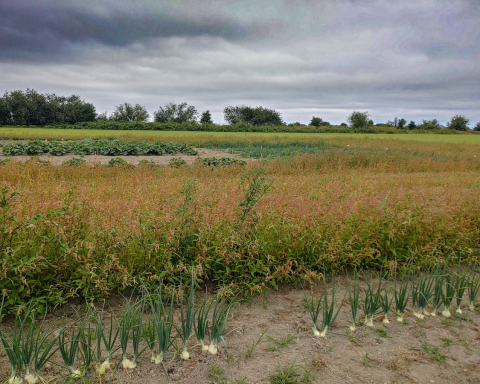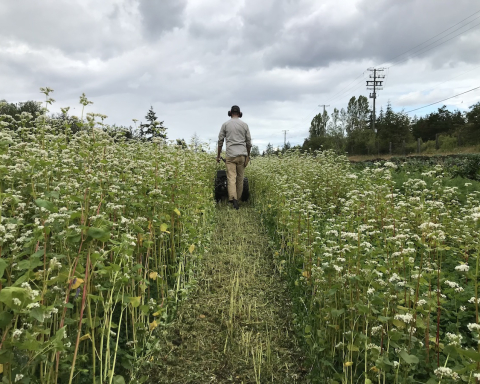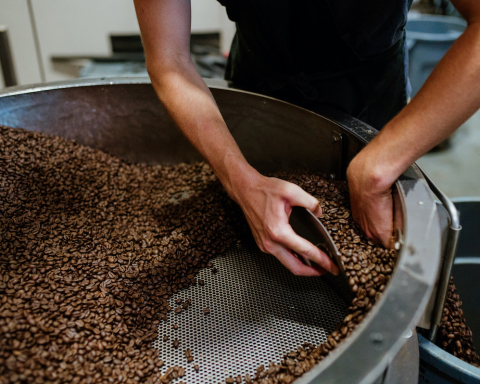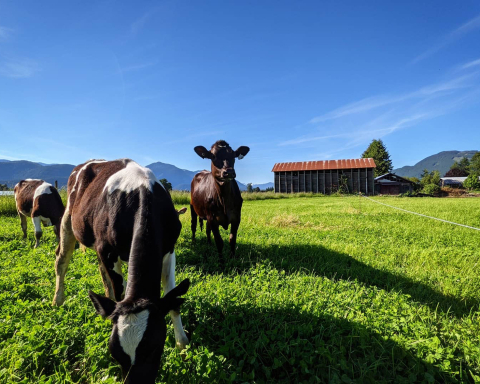Marjorie Harris, BSc, IOIA VO, P.Ag.
New Techniques for Organic Nutrient Management
As the International Year of Pulses draws to a close it is nice to give a tip of the hat to pulses, the peas and beans, and to their leguminous cousins, alfalfa and the clovers. Research has demonstrated that legumes in symbiotic relationship with Rhizobacteriums biofertilize the cropping system by fixing prodigious amounts of nitrogen from the air. Able to deliver hundreds of pounds of nitrogen per acre, legumes are an extremely valuable green manure crop to include in crop rotations.
2016 marked the 25th anniversary for Canada’s oldest organic vs conventional comparative study conducted by the University of Manitoba at the Glenlea Research Station. The organic cropping research primarily focuses on long term crop rotations for grains and green manures.
This year Martin Entz, lead researcher, in conjunction with Joanne Thiessen Martens, and Katherine Stanley, rolled out a two year consultant training program for their new Organic Nutrient Management (ONM) system. Currently only 10 consultants from across Western Canada are enrolled in the hands-on training working directly with farmers to implement the ONM system.
The ONM program is designed to track the soluble and plant available nutrients Nitrogen (N), Phosphorous (P), Potassium (K), and Sulphur (S) as they move on and off the farm as imports and exports through an 8 year crop rotation plan. The ONM also includes livestock production within the system.
New nutrient monitoring techniques are employed that rely on leguminous plant tissue bioassays to understand how plant tissue nutrient concentrations relate to soil fertility conditions. Interpreting this kind of data is still quite new, although research has proven that this type of data can lend useful insight for long term soil fertility nutrient management strategies.
There are two parts to the data development. Part 1 determines the nitrogen xation and nutrient concentration rates of N, P, K, S for the legume green manure cover crops on a per acre basis. Part 2 creates a net summary balance of N, P, K, S for imports and exports over an 8 year crop rotation on a per acre and per whole field basis.

Part 1: Determine level of nitrogen biofertilization in pounds per acre and green manure nutrient uptake.
Step 1: Dig up legume roots to check for nodular growth and nodular activity. It is important to inoculate the legumes with the appropriate symbiotic Rhozobacterium for optimum nodular development. The root colonizing Rhizobacterium form large ball-like nodules on the roots of peas and beans, and smaller at, hand shaped nodules on clover and alfalfa roots. When the nodules are actively fixing nitrogen the inner flesh of the nodule will turn a reddish color when broken open and exposed to the oxygen in air. If the inner flesh of the nodule is brown, green or clear the nodule is not actively fixing nitrogen.
Step 2: Cut biomass samples of legumes from a predetermined number of quadrants per field. Sort the legumes from the cut vegetation to record the percentage of legume vs weeds and other plants, then send the total biomass for plant tissue nutrient analysis.
Step 3: From the same plant sampled field take soil samples at 6 and 24 inch depths and send for nutrient analysis. Phosphorous and Potassium are relatively stable in the top six inches of soil whereas Nitrogen and Sulphur are more mobile and tend to leach down through the soil profile, the 24 inch depth sample will capture this movement.
Step 4: Enter the plant tissue and soil fertility results into the specified Excel spreadsheet to calculate nitro- gen biofertilzation per acre. The plant tissue results will also demonstrate if the legumes have sufficient P, K, & S for optimum growth. Long term research has shown that many legumes only need a soil test P at 5 – 9 ppm, to produce optimum nitrogen. However, a soil test rating of 5 – 9ppm P will be reported as Low as a standard soil test interpretation. Martin Entz’s research demonstrates that 5 – 9ppm P is sufficient for good legume growth. Most other crops will require supplementary nutrients for optimum growth.
The three main supplementary forms of phosphorus are: livestock manures, rock phosphate, and animal feeds. Rock phosphate has been shown to be a very slow releaser of plant available phosphorous. The ONM general recommendation for supplying a plant bioavailable form of P is a periodic light application of livestock manure, whether composted or spread raw followed by a green manure cover crop to catch the nutrients up into the plant tissue for slower release of plant available P.
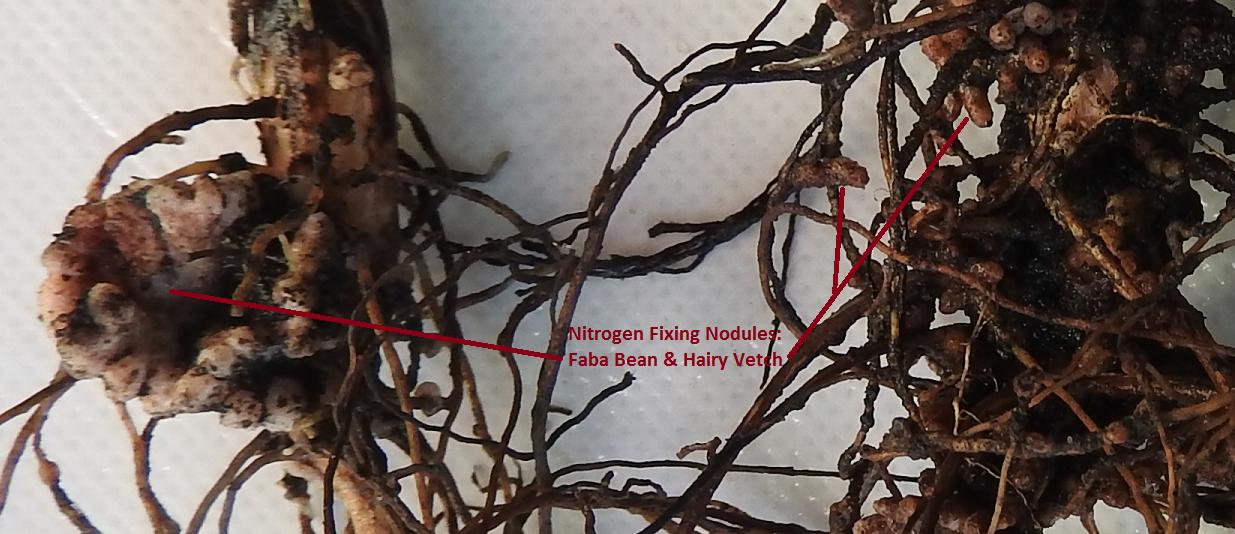
Part 2: Determining the net summary balance import and export of nutrients N, P, K, S, through an 8 year crop rotation per acre and per whole field.
Step 1: Send samples of exported farm biomass, seed, plant, and livestock manure for nutrient testing. Enter results into the ONM Excel spreadsheet. The import, export, and nitrogen fixation biofertilization date is entered and automatically calculated per field per year and then summarized over the 8 year crop rotations on a Whole Field (total acreage) and Per Acre basis.
Examples of 8 year rotation: Table 1.1 is the standard crop rotation the farmer has traditionally employed. The farmer noticed that his yields were falling and that weeds were starting to encroach the crop.
Table 1.1 – Traditional Crop Rotation Plan

Table 1.2 – Modified Crop Rotation Plan

This new approach to Organic Nutrient Management over long term crop rotations employs biomass nutrient uptake monitoring and soil testing. The laboratory data generated is entered put into the ONM Excel spreadsheet for net import and export nutrient calculations. The summary results allow the operator to visualize the long term results of various combinations of crop rotations and nutrient supplementations.
Regular green manure crop rotations provide nitrogen biofertilization and assists in the building and maintenance of soil fertility. Higher seeding rates of legume and cover crop can help suppress weed pressures. Plowing down green manure cover crops, straw, and plant waste helps to increase organic matter in the soil. Overall higher soil fertility will increase crop yields and promote healthier disease resistance plants due to sufficient plant available nutrients for optimum growth conditions.
The Glenlea long term research project has proven that organic rotational cropping systems that rely on perennial forage legumes are 222% more energy ef cient than conventional farming techniques. The energy efficiency in the organic management system was attributed to the vast reduction in the use of fossil fuels and the reduction of greenhouse gas emissions associated with burning them.
This is a very brief overview of the University of Manitoba’s new Organic Nutrient Management system. For more in-depth information about implementation and to develop long term nutrient management strategies using green manures and nutrient supplements contact Marjorie Harris, Organic Nutrient Management consultant, at ecoaudit@telus.net.



